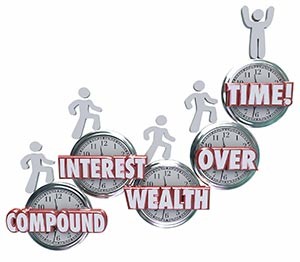 Most of us cannot deny that we daydream about our lives post retirement. In those dreams, we may be cruising half way across the globe or just indulging the gardener in us. We dream of an easy life full of small nothings and crazy ‘somethings’. This is how we are programmed: we know we have to slog it out while we are part of the active workforce and get rewarded for it with a leisure-filled retirement.
Most of us cannot deny that we daydream about our lives post retirement. In those dreams, we may be cruising half way across the globe or just indulging the gardener in us. We dream of an easy life full of small nothings and crazy ‘somethings’. This is how we are programmed: we know we have to slog it out while we are part of the active workforce and get rewarded for it with a leisure-filled retirement.
So it may come as a rude shock if you do not find enough in your nest egg to retire peacefully and may be work through your 70s to make ends meet. The crux question then is- how much do you need to retire at 65? Let us find out. You will be surprised by a few stats and one trend in particular.
How much money you may need to retire comfortably?
Talking of Super, what your employer contributes may turn out to be a paltry sum. It is then important that you keep making voluntary contributions from your side all through your working life. So the question once again- how much is likely to be enough? To sort this out, you need to ponder over a few things. First, what kind of lifestyle are you looking for? Second, what may be the medical costs in future? And third, how long you are going to live (while this cannot be determined by us, we should, at any rate, budget for “higher life expectancy”)?
Figures for couples and single retirees
If you aim to retire at 65 and live till 85 (hypothetical assumption), you may require $34,000 annually to enjoy a modest retirement as a couple. If you are looking for a comfortable retirement, this figure comes up to $59,000. If you are single, a modest retirement may ask you to fork out something like $23,500 annually while a comfortable retirement may dent your pocket by $43,000 per year.
Looking at a 20-year retirement period
 There is a consensus that a couple needs a lump sum of $640,000 (the figure is $545,000 for a single person) to eke out a comfortable retirement provided they are looking at a 20-year period and also assuming that the couple gets a partial age pension. Of course, this calculation does not budget for an unnatural increase in inflation and subsequent surge in food prices, prices of utility bills and enhancement in lifestyle or the spending habits of a particular demographic.
There is a consensus that a couple needs a lump sum of $640,000 (the figure is $545,000 for a single person) to eke out a comfortable retirement provided they are looking at a 20-year period and also assuming that the couple gets a partial age pension. Of course, this calculation does not budget for an unnatural increase in inflation and subsequent surge in food prices, prices of utility bills and enhancement in lifestyle or the spending habits of a particular demographic.
Comparing modest and comfortable retirement
Comfortable retirement
When we talk about a comfortable retirement and in comparison a modest retirement, what do we actually intend to say? To break it, a comfortable retirement implies an annual holiday in Australia, regular visit to restaurants (decent to good food quality), affording quality clothes, bottled wine, a nice range of electronic equipment, private health insurance, enough funds to renovate kitchen and bathroom over the course of 20 years, owning a decent car and taking part in hordes of leisure activities which come at a cost.
Modest retirement
On the other side, a modest retirement means that you get one, or at best two, short breaks in close proximity to where you live, sparse dining opportunities (and cheap food), an old car, cask wine, reasonable clothing, air conditioner-less life, paucity of budget to undertake home renovation, and a few trips to the cinema in terms of leisure activities. Yes, private health insurance still remains within your reach.
Retirement based on age pension
And if you are banking only on the age pension, you need to cut your desire even further and settle for cheap takeaways, home brew beer, modest clothes, inefficient heating, no private insurance and no renovation budget.
The difference between feature and benefit, I learnt in my young days, is that the benefits arrest the interest of a layman. Similarly, when we talk about retirement needs in figures, they do not make much of a mark. However, when we break them down to what the figure might mean, we get a clear impression of how we may be spending our future lives.
Here is hoping that the above three paragraphs made amply clear what a comfortable, modest and age pension-based retirement might mean for you.
Here are some pretty relevant stats:
- The Australian Bureau of Statistics informs us that as many as 1.8 million Australians are banking on age pension to float in their retirement lives. The vision is one of “just floating”.
- There are a shade in deficit of $600,000 who are relying only on Super income.
- For the year 2011-12, half the population of retiring couples made less than $28,260 a year. In the same context, single retirees posted a figure of $21,700.
Higher life expectancy
 With life expectancy rising and men living up to 88 and women up to 91 (average), we are going to need a lot more money in our nest egg to fund our retirement. The above statistics do not seem all too creditable in taking us towards our retirement goals; certainly nowhere near a comfortable retirement.
With life expectancy rising and men living up to 88 and women up to 91 (average), we are going to need a lot more money in our nest egg to fund our retirement. The above statistics do not seem all too creditable in taking us towards our retirement goals; certainly nowhere near a comfortable retirement.
The tale of Baby Boomers
The first “baby boomers” are just about settling into what was supposed to be their golden retirement years (I am talking about the generation of our elders who were the first to enjoy comfort and know what luxury meant). Yet, if you look through Google, you will find “retirement crisis” to be a trending term. So, how come the baby boomers lost the plot? What made them horde insufficient retirement funds? And if they can go wrong, can’t we? These are some of the questions bothering us.
U.S is not faring any well either
And we are not halfway through the daunting facts yet. In fact, I would not say that Australia is the only country facing such problems. For instance, here is taking a look at how the USA is faring: For those U.S households which have members over the age of 55, as many as 29% do not have any retirement saving or a conventional pension plan (data provided by the Government Accountability Office).
Needs are individual in nature, driven by personal urges
But it is Australia and the destiny of its retirees which is the cause of prime concern for us. So, let us come back to the discussion table. How much you need to retire comfortably is, truth be told, a rather complex question. Different people have different needs and though they are knit with the collective thread of the society, human beings have individual sparks and respond to personal urges. What is good for John may be just about okay for Tom and much less than sufficient for Jim.
Each household may have its own unique circumstances and thus the true cost of retirement may be a highly personalised equation after all. Looked another way, it is expenses and not income which should be the prime factor for budget consideration. Dollar amounts are arbitrary. If you spend too much, high dollar savings are not going to save you, are they?
Expenses and not income must be looked at
 Also, it might not be prudent to read too much into income because they can vary greatly over the period of work lives. What may really matter is your retirement expenses. If you have a paid-off home and kids who are fairly independent, you can live off far less than what you earn. So you see, there are just too many aspects which need being factored in. While envisioning your responsibility as retirees, you must, before all else, figure out just who will you be responsible for. Is it only your spouse or others are also in the fray?
Also, it might not be prudent to read too much into income because they can vary greatly over the period of work lives. What may really matter is your retirement expenses. If you have a paid-off home and kids who are fairly independent, you can live off far less than what you earn. So you see, there are just too many aspects which need being factored in. While envisioning your responsibility as retirees, you must, before all else, figure out just who will you be responsible for. Is it only your spouse or others are also in the fray?
The “25 times your pre-retirement income” model
There are many variables which have to be studied before you nail your “how much” answer. When we are young, our objective is to build on our retirement savings. When we go up the ladder of age and reach 50 or 60, our main focus turns towards just how to find the resources to keep building the retirement nest egg and accumulating wealth for the purpose. One school of reasoning suggests that we should have 25 times the value of our estimated annual retirement income.
To calculate through a hypothetical instance, if we need $55,000 as annual retirement income for a comfortable retirement and our guaranteed income through pension is X then our goal should be to have a nest egg of ($55,000- X) multiplied by 25. Of course, this is not an absolute thought. Just as I mentioned, there are too many variables that enter the wide picture; and some of them are really “beyond the box” variables.
For example, how about saving all life and knowing on the verge of retirement that you will have to spend your retirement years in America where the figures may be completely different. Or maybe you just hit on an unexpected inheritance!! Who knows?
You may need two-thirds of your present income
If you think retirement is something that “happens to others”, think again. You are moving towards it at the rate of 60 minutes an hour and it is time you actually started tracking your expenses and making your post-retirement budget. You are likely to need about 67% or two-thirds of your present income after retirement. And one can never say enough about the future living costs. Might be they won’t go up all that high and you can offset the marginal increase by cutting spending but there might just be a case of sudden upsurge, too.
Economists are always wary of such unanticipated peaks during a 10-year cycle. Who takes the biggest brunt? The generation which is passing through retirement in those 10 years; so it is obvious that you cannot be too well prepared.
Also, higher life expectancy and lower mortality rate means that we are more likely to touch the 90th winter of our lives than any of our predecessors. I know we all have an aunt or an uncle who celebrated their 100th birthdays but such instances are few and far between. For all we know, it might become a norm in a couple of generation’s time.
Compound interest is a magic bullet
 So, if we live more, we need to plan for the longer retirement stretch. This translates into a bigger nest egg, right? The happy point is that even if you haven’t saved as much as you should have ideally, you can double up your life’s savings in the last 10 years of your work life. Compound interest is a magic bullet, after all!
So, if we live more, we need to plan for the longer retirement stretch. This translates into a bigger nest egg, right? The happy point is that even if you haven’t saved as much as you should have ideally, you can double up your life’s savings in the last 10 years of your work life. Compound interest is a magic bullet, after all!
Those with a retirement portfolio
When we say not all of us plan that well, we do not take into equation those retirees who have already done the hard labour of retirement planning. There are definitely a few among us who know where they are heading. A majority of them have a retirement income portfolio. When we are talking about such retirees, the question that comes to mind most often is, “how much can be taken out of the investment portfolio each year”. There is no ‘one’ answer for it. Many schools of thoughts look equally convincing.
4 percent rule
I have long heard, and quietly believed, in the 4 percent rule. This suggests that you should withdraw 4% of your retirement portfolio each financial year and add corresponding inflation to the base sum each year.
To illustrate, let us suppose that you have an $800,000 portfolio at the time of retirement. So, the 4 percent rule suggests that you should take out $32,000 in the first year. Let us further suppose that the inflation next year is 1.5%. In the given case you should withdraw $32,000 plus (1.5% of $32,000) or $32,480.
One year further, assuming that the inflation is 1.6%, you should withdraw $32,480 plus (1.6% of $32,480) or $32,999. The four percent rate remains constant in its approach despite a drop or a rise in the market.
Market-based approach
 Another approach is the market-based approach. This one bases the retirement withdrawal rate on two variables; the positioning of stocks in the portfolio (the risk profile) and the market capitalisation. This is more intricate than the 4% rule and the general withdrawal rate turns out to be higher than 4% even for the very conservative investors.
Another approach is the market-based approach. This one bases the retirement withdrawal rate on two variables; the positioning of stocks in the portfolio (the risk profile) and the market capitalisation. This is more intricate than the 4% rule and the general withdrawal rate turns out to be higher than 4% even for the very conservative investors.
What constitutes an optimal retirement plan?
Optimal retirement planning entails exactly who you are today and what you are likely to be tomorrow and what best can you do to bridge the gap between ‘today’ and ‘tomorrow’ so that you can make a smooth transition to the retirement years. Retirement, I have written in the past, is not a time, it is a place- and how beautiful and soothing the place looks depends upon the effort you make.


